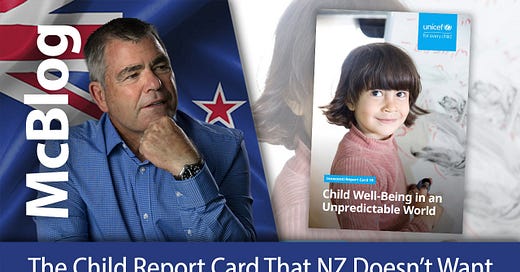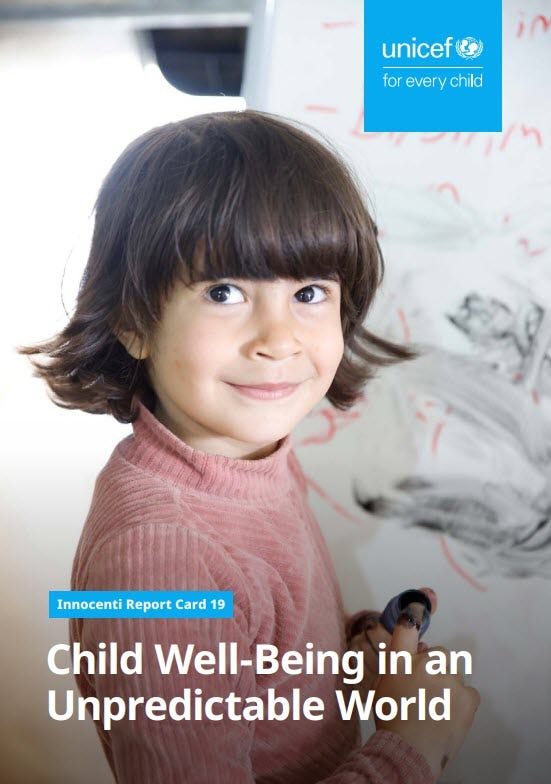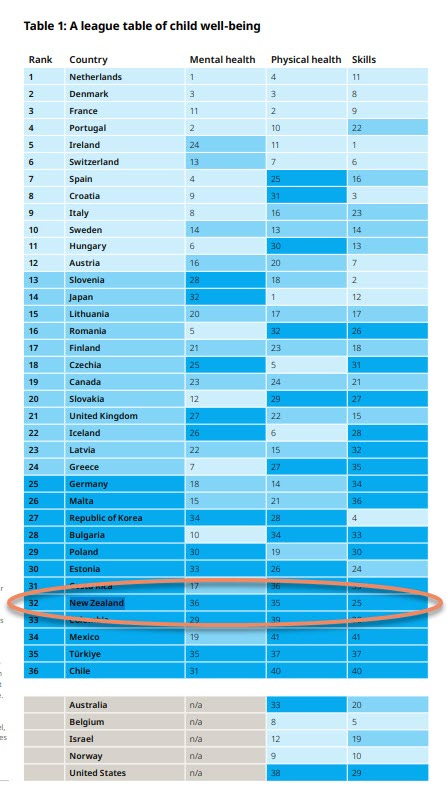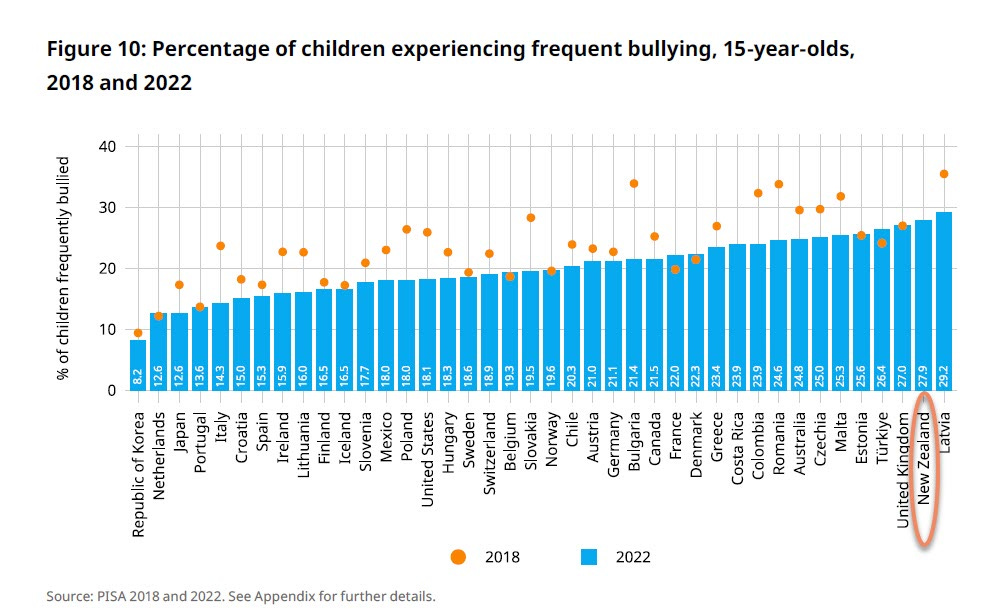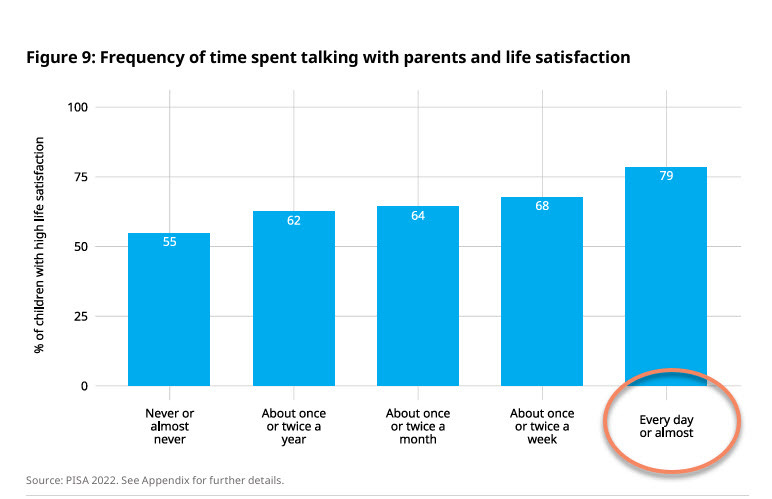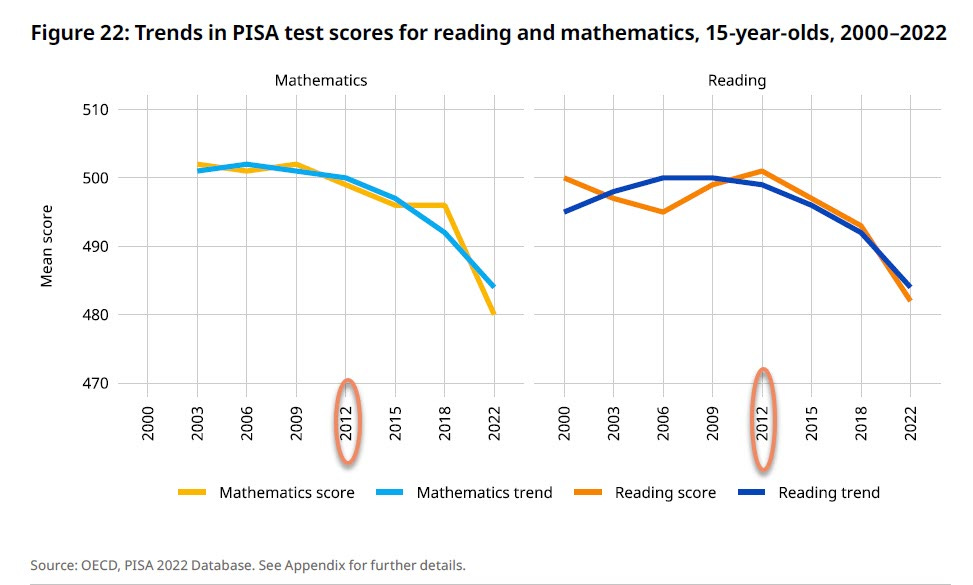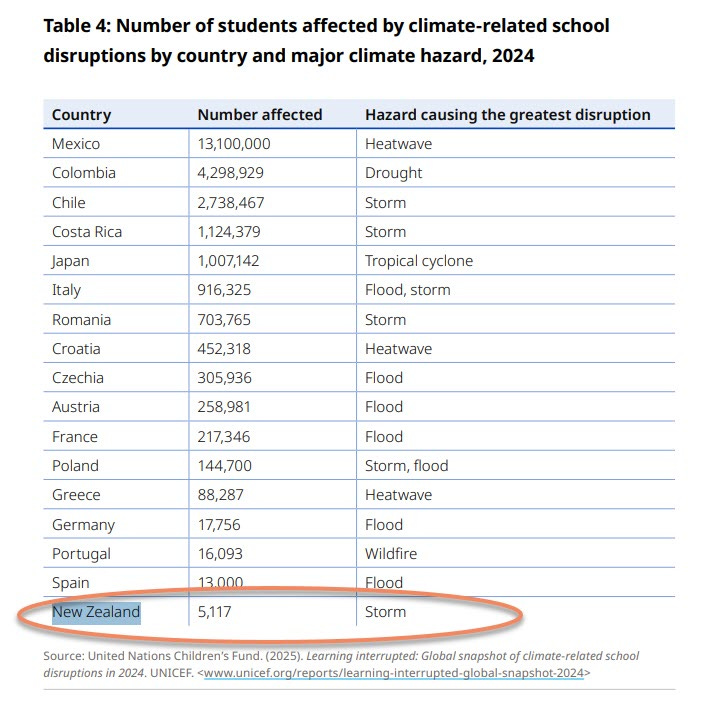The Child Report Card That NZ Doesn’t Want
The problem with UNICEF and these reports is that they can identify the problem. That’s the easy part. They just can’t – or won’t – point to the obvious and time-tested solutions. But we will.
UNICEF have released their latest report card on the wellbeing of children and it surveys 43 countries that are members of the European Union (EU) and/or the OECD – high-income countries.
It’s called Report Card 19: Fragile Gains – Child Wellbeing at Risk in an Unpredictable World and uses globally comparable datasets between 2018-2022.
It looks at life satisfaction, adolescent suicide, child mortality, overweight, academic proficiency and social skills – and seeks to understand the reasons for these trends and how they can inform actions to improve child well-being.
New Zealand is included in this dataset, and if you were a child taking home this report to your parents from your school teachers, you would either bin it or eat it on the way home.
It makes disturbing reading.
Right from the outset of this report, we see just how low New Zealand is compared with other countries.
Overall we are 32nd out of 36 countries – virtually in the relegation zone in permier league football terms. But for mental health we are 36th – the worst. For physical health we are 35th worse out of 41, and for education skills – slightly better at 25th.
But the worst for mental health. That is shocking.
Then they show the changes – have we improved, deteriorated or shown relative stability in the data. Blue is improved. Orange is worsened. Grey is remained the same.
As you can see, we’ve worsened in suicide and academic performance. We have improved on lower child mortality – which is good.
Why do we rate so badly in mental health?
Here’s the suicide rates for 15-19 year olds. That’s us out the far right. And the orange dot represents the rate in 2018 – and the blue block is the rate now. It’s worsened. If the orange historical dot is in the blue block, the rate has worsened for those countries.
But note how far ahead we are of other countries.
Our rate is almost three times higher than the average for high-income countries.
And yet, taking a longer-term view, there has been notable progress in reducing adolescent suicide rates overall.
Despite so-called threats of COVID and climate alarmism and digital technology and Trump!
But not New Zealand. We’re going against the trend.
Let’s look at bullying.
Wow – 2nd worst rate of bullying. And of course bullying is associated with higher rates of depression, anxiety, and suicidal ideation and behaviour. If we want to tackle our horrendous suicide rates – tackle bullying.
But ALL bullying – not just the Pink Shirt Day bullying which is obsessed with the narrative of pushing radical sexuality and gender ideology on our children.
Kids get bullied because of weight, looks, ethnicity (one of the most common forms actually), disability, struggling with school work, uncoordinated or terrible at sports – you know the story. We’ve all seen it and likely even done it when we were at school. It was never an LGBT thing. It was a human thing.
And speaking of bullying people for their weight or looks…
The prevalence of overweight and obesity in children is growing globally. From an average of 17 per cent way back in 1990 to around 28 per cent in 2022.
And in New Zealand you’ll see we have the third worst rate of being overweight or obese.
And this is only going to get worse if we continue to see an increase in screentime and a decrease in physical activity. The cellphone ban in schools is just a start.
In terms of child mortality, we’re in the top third – fortunately not the worst,
But the commentary is interesting
The risk of child mortality is unequal and is linked to family economic factors… In the United States, children whose mothers have not graduated high school were estimated to face a 40 per cent higher risk of early life mortality than children of college graduates. This disparity was partially driven by unintentional injuries and interpersonal violence. In Japan, infant mortality rates were found to be highest in households with unemployed adult members. The gap in infant mortality rates between employed and unemployed households has widened between 2019 and 2022. It is important to remember that, in addition to child mortality, income inequality drives multiple disparities in children's health outcomes
They also surveyed about life happiness and satisfaction. You’ll see the following
Girls are much less likely to have high life satisfaction than boys.
Socioeconomic status didn’t make that much difference
Exercising regularly is linked with higher life satisfaction.
High use of social media use is linked with lower life satisfaction.
Frequency of talking with parents is strongly positively associated with life satisfaction.
And no surprise – the frequency of being bullied has a strong negative association with life satisfaction.
In fact, let’s look at that parental engagement one
And we’re not doing too badly. 80% of adolescents say they spend time talking with their parents – although “at least once or twice a week” is a very very low bar, isn’t it.
But children are most satisfied if talking with parents “every day or almost every day”.
Nice.
The report says
Children who spent more than seven hours a day on social media had significantly lower than average life satisfaction, but this is a small group making up only around 6 per cent of 15-year-olds. Moreover, it is possible either that spending a lot of time on social media causes lower life satisfaction, and/or that children with low life satisfaction tend to turn to intensive social media use.
But overall, children aren’t happy. In the large majority of countries, the proportion of children with high life satisfaction fell between 2018 and 2022. The magnitude of this decrease was, in nearly all countries, larger among girls.
And sadly, our teens have the 6th lowest rate!
A couple of others…
Academic skills is defined as the proportion of children who are still at school at age 15 and have reached basic proficiency in both reading and mathematics.
We’re slightly above the average – although we have dropped from the orange dot – but note that most countries have a drop from the orange dot – the 2018 figure.
Here’s the reading skills one. Orange is 2018. Blue is now. So most countries have got worse. We’re in the bottom half.
And of course everyone will blame COVID and lockdowns and climate change – but in fact you can see the trend started around 2012.
What else happened in 2012. That’s when smartphones really became common.
Should we be surprised that reading and math rates declined as a result?
I did chuckle at this one. To push the narrative of climate alarmism, they showed this chart. Number of students affected by climate-related school disruptions by country and major climate hazard, 2024
13 million in Mexico. 4 million in Colombia, and almost 3 million in Chile.
5,000 in New Zealand due to a…. storm.
So overall – it’s a shocking report card.
32nd out of 36 countries overall. But for mental health, the worst.
Here’s the key – we actually know the answers to this problem.
In 2007 the UNICEF report looked at child well-being said that key risk factors are:
parental drug or alcohol abuse
family breakdown
single parenthood and weak family ties - in other words decreasing marriage rates
poverty and poor housing - which often results from that from that poor family formation
low maternal age at birth - in other words teenagers having children
A CYF report in 2006 and a Children’s Commissioner report in 2009 also said those were the factors.
In the 2016 report, “Child Abuse & Family Structure: What is the evidence telling us?,” the research suggests the growth of child abuse in New Zealand has accompanied a reduction in marriage rates and an increase in cohabiting or single-parent families – broadly, child stability versus instability.
For the past 50 years, families which feature ex-nuptial births, one or both parents absent, large numbers of siblings or very young mothers have been consistently over-represented in child abuse statistics.
In 2022 we released a report, “Child and Youth Mental Health: Why New Zealand's young lead the developed world in poor mental health”
Now Lindsay Mitchell has been researching and commenting on welfare since 2001. She has written a number of reports for us over the past 6 years showing a link between the weakening of family and marriage to worsening social trends.
Child Poverty
Child Abuse
Imprisonment
Fertility
Step-Families and the challenges
NZ’s teen birth rate
Father Absence
In this report on mental health and young people, she says that what she found was NZ has the worst youth suicide, self-harm and bullying statistics – confirmed in this latest UNICEF report.
Mental disorders have risen significantly, as has consumption of antidepressants and anti-psychotics. These increases are above what is occurring in the general population.
Now the report gathered data from the New Zealand Health Survey, Mental Health and Addiction Services monitoring reports, Pharmac, DHBs, various longitudinal studies, Oranga Tamariki, MSD and Youth 2000 surveys.
Lindsay says
"On the available evidence, New Zealand undoubtedly faces a mental health crisis among the young. But this may be just part of the picture. For instance, the Growing Up in New Zealand study has lost touch with hundreds of children who are the most likely to be suffering poor mental health due to exposure to accumulating adverse experiences associated with transience; multiple parental relationship transitions; young, deprived, and poorly educated mothers who disproportionately experience hardship and depression.”
She notes that “According to Oranga Tamariki, '…the alcohol and drug issue is prolific / increasing' among Family Start clients, and various data suggests thousands of babies are exposed to alcohol and other substances in utero."
Speak to many primary school teachers and they will concur with this observation
Lindsay refers to “…a more pervasive depression and anxiety problem exacerbated less by mayhem and material deprivation, and more by recent developments such as social media-driven poor self-image, heightened sensitivity to parental and/or peer pressure, fear of failure, climate change anxiety and confusion over sexual and gender identity…. [They] may also be dealing with separated parents, torn loyalties, school and home-life upheaval and adapting to stepsiblings."
We need strong and stable families with strong and stable marriages – and investment especially in young families and young parents. Parents in general.
Interestingly I did a word search in the latest UNICEF report on the words ‘marriage’ ‘drugs’ ‘alcohol’ ‘divorce’ ‘separation’ ‘maternal’ etc – all the things that UNICEF rightly pointed to back in 2007.
Zero.
Discussion around family relationships and parent interaction – yes - but very little about strong family formation, the right of a child to their biological mother and father, the risk factors of substance abuse, the risks of low maternal age and non-related adults in the house, and nothing around the protective factor of marriage or biological fathers or mothers.
And that’s the problem with UNICEF and these reports.
They can identify the problem. That’s the easy part.
They just can’t – or won’t – point to the obvious and time-tested solutions.
But we will.
By the way, in the Budget this week, there will be a new $190m Social Investment Fund designed to transform the way the social services are delivered to vulnerable New Zealanders.
Government agencies currently spend about $7 billion each year buying social services designed to improve lives from non-government agencies.
Do you think $190m – dictated by the Government – is going to make any difference?
The Government can’t solve this problem – irrespective of how much they fund it.
Only strong marriages and families, a respect for life, protecting children from sexualisation and confusion, and a return to biblical morality & standards will turn this around.
But I’ll get cancelled for saying that.
Again.

